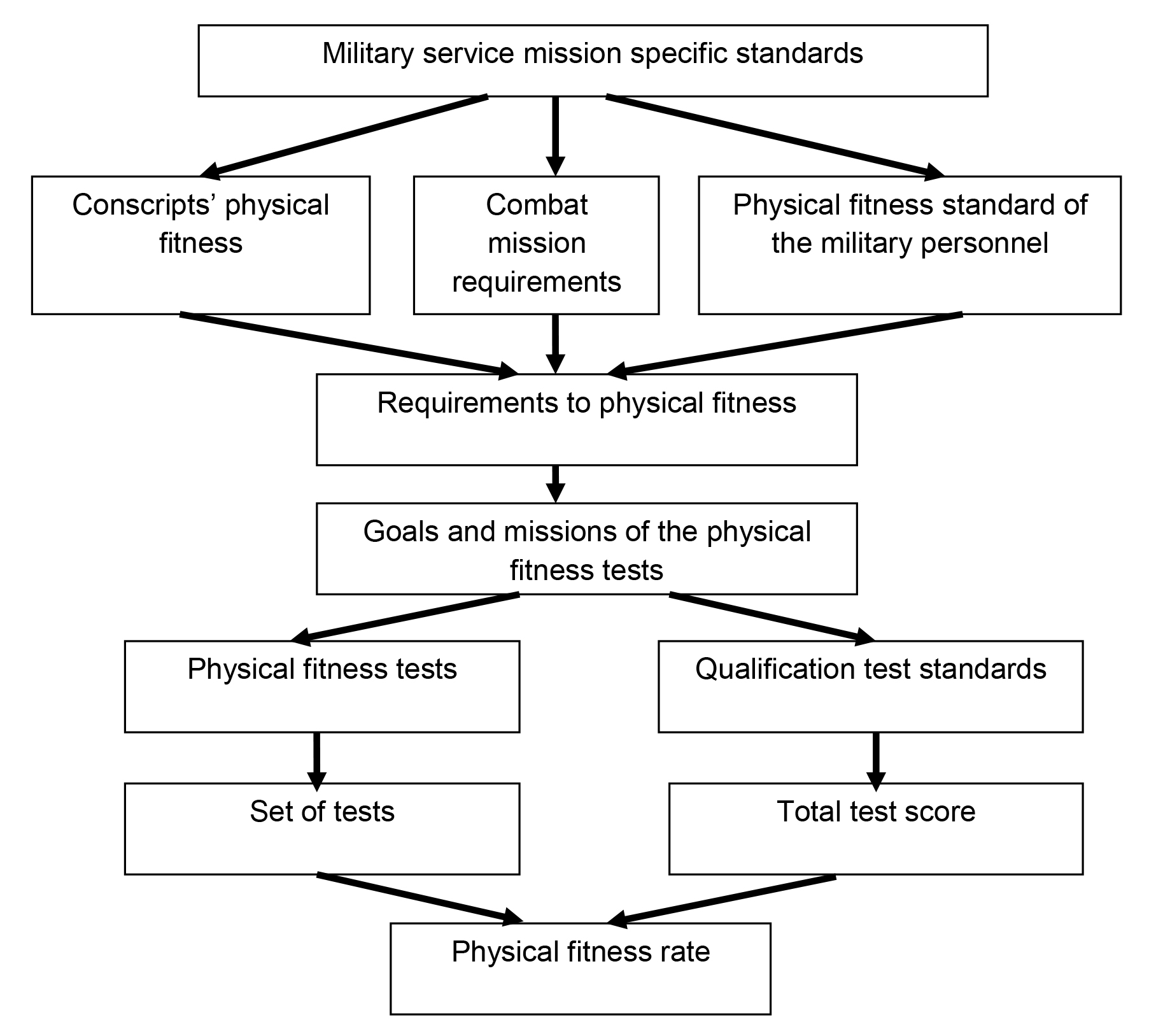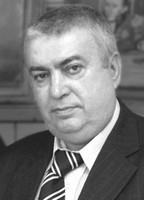Practical methods to improve military personnel physical fitness rating tests
Фотографии:
ˑ:
Dr.Hab., Professor R.M. Kadyrov1
PhD, Professor V.D. Getman1
1St. Petersburg State University of Architecture and Civil Engineering, St. Petersburg
Keywords: test set, point scoring system, physical fitness.
Background. Physical fitness is one of the core notions applied in the modern physical education (PE) system. Military personnel’s physical fitness may be interpreted as the physical development standard that secures the weapons and combat machinery being used in the most efficient manner with high resistance to the harmful effects of the service practice environments [2]. A set of the relevant physical fitness tests is applied to rate the personnel’s ability to fulfil the PE process missions as verified by the relevant qualitative and quantitative test criteria [3]. The service-specific physical fitness range may be quite wide unless the specific difficulty and relevance levels are determined and then the most relevant and informative tests are applied.
Objective of the study was to consider and analyse the most promising practical process management methods of the military personnel physical fitness rating tests.
Methods and structure of the study. Subject to experiment under the study were the first-year cadets of military education establishments, with their physical fitness tested using the standard physical progress rating test exercises as provided by the Armed Forces Personnel Physical Training Regulations (PTR-2009) [4]. Body weight rates, РWC170 were generated by the commonly accepted methods with the maximal oxygen consumption (MOC) rate calculations [1]. Physical fitness was rated by the standard combat sport exercises.
Results and discussion. It should be noted that the conscripts’ primary physical fitness levels are not different from those of the general population of the relevant age group. When, for instance, the fitness level is initially low (3-4 pull-ups on horizontal bar and 3km race time of 16+ min), the PE time of the valid training course and involuntary military service is often not enough to develop the required physical fitness standards. In view of the wide variety of the valid requirements to and aspects of the service-specific physical fitness, a top priority in the training system shall be given to some selected fitness aspect or one should seek to harmonise the specific fitness aspects and rate them by the relevant fitness standards and tests.
The military personnel’s physical fitness aspects may be generally listed as follows: specifics of the special education and combat missions; entry physical fitness rates applied to qualify the conscripts; physical fitness standards applied at the relevant foreign armed units etc. [1]. The requirements and standards are widely varied across units and elements of the Russian Armed Forces as required by their specific education and combat purposes and missions. Generally, different physical fitness standards may be set for the Ground Forces, the Navy and the Russian Aerospace Forces: see Figure 1 hereunder.

Figure 1. Military personnel physical fitness rating model
The priority military personnel physical trainings and tests shall be designed to include the following components:
- Special training practices closely mimicking combat missions in terms of physical loads and intensity levels, including, for instance, rowing practices for the Navy personnel; special hurdle races for the Ground Forces, and special training simulators and tools for the Aerospace Forces;
- Special test rates within the general test standards applicable indiscriminately in the Russian Armed Forces. The special test rates shall be compliant with the actual specific requirements to the military personnel physical fitness in the relevant military specialty/ unit. Different sets of physical fitness test exercises may also be applied in different elements of the Russian Armed Forces, conditional on every set providing the most relevant and objective physical fitness rates as required by the variety of potential combat missions.
The physical fitness scoring system may apply the following three rating levels:
1) ‘Excellent’ when an individual is perfectly physically fit for combat missions;
2) ‘Good’ when an individual is basically physically fit for combat missions; and
3) ‘Satisfactory” when an individual is minimally physically fit for combat missions.
As was mentioned above, virtually every conscript of the new generation is tested unfit for a variety of combat missions and, hence, may qualify at best for the third (satisfactory) fitness level in some tests, with some physical progress expected only as a result of the relevant target PE course.
In the military personnel physical health examinations and second-level tests, special test exercises may be applied to rate only specific physical and morpho-functional characteristics and abilities. The high (excellent) physical fitness rates shall be demonstrated by patrollers, paratroopers, aircrew, Navy personnel qualified for some missions etc. It should be noted that specific physical fitness rates may be different albeit still dictated by potential special combat missions.
Personnel physical progress tests in the physical education process shall take into account variations of the morpho-functional indices, with their analysis providing important guiding data for finding correlations of the physical progress versus the morpho-functional indices; and variations of the physical progress and functionality rates as verified by the progress tests. As demonstrated by Table 1 hereunder, the heavyweight servicemen (with the body mass of 12kg in excess of the norm) are tested with slower run speed versus the high absolute and lower relative maximal oxygen consumption (MOC) rates – that is indicative of the obvious negative effect of excessive weight on the 1km race speed.
Table 1. 1km test rates versus the maximal oxygen consumption (MOC) rates of the heavyweight (12kg above the norm) servicemen (Х±m)
|
Body mass, kg |
MOC, ml/min |
MOC, ml/kg/min |
Race speed |
Result, s |
|
|
m/s |
km/h |
||||
|
82,5±1,77 |
3,26±0,06 |
39,3±1,31 |
4,58±0,08 |
16,5±0,31 |
212,9±5,7 |
|
82,6±1,9 |
3,16±0,06 |
38,3±1,14 |
4,37±0,08 |
15,7±0,29 |
226,6±3,9 |
|
81,9±0,6 |
3,09±0,02 |
37,5±0,36 |
4,08±0,04 |
14,6±0,16 |
246,2±2,7 |
|
88,1±3,4 |
3,13±0,06 |
36,8±0,6 |
3,65±0,08 |
13,1±0,3 |
292,4±6,5 |
The test data show that the military servicemen tested with the relative MOC rate under 37 ml/kg/min may be qualified functionally incapable by the endurance rating tests. It should be noted that even if they somehow meet the minimum race speed standards even with their MOC levels being highly motivated for success, the success is often achieved at detriment for the cardiovascular system functionality.
It is common knowledge that the higher is the body mass the lower is the relevant MOC rate. In addition, our test findings give the grounds to conclude that virtually every individual was tested with poor musculoskeletal structure, relatively low anaerobic endurance and low static balancing abilities albeit good adaptability of the cardiovascular system and fair physical working capacity rates (PWC170). Therefore, most of the service personnel qualify in the race tests although the success is achieved thanks to the cardiovascular system resource mobilisation. The heavyweight servicemen are generally tested with higher strength although in the tests on a horizontal bar (pull-ups, muscle-up and hip pull-over tests) they naturally lag behind the servicemen with low to standard body mass.
For the purposes of the physical and competitive progress tests by the end of the academic year, we grouped the personnel into sport qualification groups different in physical fitness ranges. In the ‘excellent’ rated groups, the physical fitness rate correlation with the sport qualification may be described by the following equation:
y = 1.21x – 19.9, where
у means the percentage of the sport qualifiers; and
х means percentage of the successful physical fitness tests.
In the ‘good’ rated groups, the physical fitness rate correlation with the sport qualification may be described by the following equation:
у = 1.08х – 12.2, where
у means the percentage of the sport qualifiers; and
х means percentage of the successful physical fitness tests.
And in the ‘satisfactory’ rated groups, the physical fitness rate correlation with the sport qualification may be described by the following equation:
у = 83.0 + 0.024х, where
у means the percentage of the sport qualifiers; and
х means percentage of the successful physical fitness tests.
Solutions of the above equations give ground for the competitive fitness assessments. It should be mentioned that the direct correlations of the physical fitness rates and sport qualifications make it possible to rate both parameters at the same time. In addition, the above equations may be applied to quantitatively assess the potential competitive fitness of the military personnel. In practical terms, it may be reasonable to apply uniform standards for the physical and competitive fitness rating tests due to the following considerations:
– The personnel progress in mass sports is generally rated by a combination of physical fitness and competitive success rates;
– Content of the relevant physical education courses may be unified based on the physical and competitive fitness rating tests being combined; and
– Such a standardisation shall give the means to make the competitive progress tests more specific.
The existing system that offers different arrays of the physical fitness and competitive fitness rating tests in the mass sporting activity rating process largely complicates the attempts to obtain informative and efficient test rates. The proposed integrated tests, among other benefits, will make it possible to have the competitive progress tests being included in the education curricula of the military education establishments to simplify the progress tests and examinations. If the proposed system is further developed, the physical development and competitive training programs may be unified and standardised with the only difference being retained for the test systems.
Conclusion. The study data and analysis helped demonstrate the need for the training process goals and missions to be factored in the physical fitness tests on the whole and the military personnel physical fitness tests in particular; to offer the ways to improve the valid test systems and expand the range of the morpho-functional tests to effectively rate the competitive fitness and service-specific physical fitness.
References
- Weidner-Dubrovin L.A., Jamgarov T.T., Korobkov A.V. et al. Voprosy nauchnogo obosnovaniya fizicheskoy podgotovki v Vooruzhennykh Silakh SSSR [Issues of scientific substantiation of physical training in the Armed Forces of the USSR]. Leningrad: P.F. Lesgaft VKFFKS, GDOIFK publ., 1964, pp. 25-36.
- Kadyrov R.M., Mikhail I.I., Getman V.D. Model postroeniya fizicheskoy podgotovki [Physical training building model]. Aktualnye problemy fizicheskoy i spetsialnoy podgotovki silovykh struktur, 2010, no. 2, pp. 25-29.
- Kadyrov R.M., Mikhail I.I. Modelirovanie objema i intensivnosti nagruzok v protsesse fizicheskoy trenirovki [Physical load volume and intensity modelling in training process]. Teoriya i praktika fiz. kultury, 2016, no. 8, pp. 72-75.
- Nastavlenie po fizicheskoy podgotovke v Vooruzhennykh Silakh Rossiyskoy Federatsii (NFP-2009) [Russian Armed Forces Personnel Physical Training Regulations (NFP-2009)]. Moscow: Voenizdat publ., 2009, 200 p.
Corresponding author: grossgep@mail.ru
Abstract
The study reports practical modern methods to improve military personnel’s physical fitness rating tests by special exercises included in the standard test set, with differentiation of the test standards in the military exercises widely applied by the Russian Armed Forces, and with the test scores grouped into the excellent, good and satisfactory.
Subject to the experiment were first-year cadets of military education establishments, with their physical fitness tested using the standard physical progress rating test exercises as provided by the Armed Forces Personnel Physical Training Regulations (PTR-2009). Body weight rates, physical working capacity rates РWC170 were generated by the commonly accepted methods with the maximal oxygen consumption rate calculations. The physical fitness was rated by the standard combat sport exercises. The study data and analysis helped demonstrate the need for the training process goals and missions to be factored in the physical fitness tests on the whole and the military personnel physical fitness tests in particular; to offer the ways to improve the valid test systems and expand the range of the morpho-functional tests to effectively rate the competitive fitness and service-specific physical fitness.



